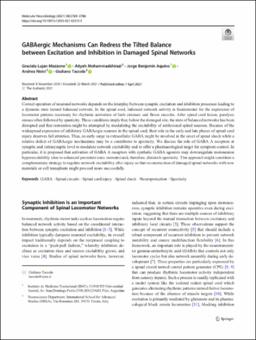GABAergic Mechanisms Can Redress the Tilted Balance between Excitation and Inhibition in Damaged Spinal Networks

View/
Date
2021-08Author
Mazzone, Graciela.
Aquino, Jorge.
Nistri, Andrea.
Et al.
Metadata
Show full item recordAbstract
Abstract
Correct operation of neuronal networks depends on the interplay between synaptic excitation and inhibition processes leading to a dynamic state termed balanced network. In the spinal cord, balanced network activity is fundamental for the expression of locomotor patterns necessary for rhythmic activation of limb extensor and flexor muscles. After spinal cord lesion, paralysis ensues often followed by spasticity. These conditions imply that, below the damaged site, the state of balanced networks has been disrupted and that restoration might be attempted by modulating the excitability of sublesional spinal neurons. Because of the widespread expression of inhibitory GABAergic neurons in the spinal cord, their role in the early and late phases of spinal cord injury deserves full attention. Thus, an early surge in extracellular GABA might be involved in the onset of spinal shock while a relative deficit of GABAergic mechanisms may be a contributor to spasticity. We discuss the role of GABA A receptors at synaptic and extrasynaptic level to modulate network excitability and to offer a pharmacological target for symptom control. In particular, it is proposed that activation of GABA A receptors with synthetic GABA agonists may downregulate motoneuron hyperexcitability (due to enhanced persistent ionic currents) and, therefore, diminish spasticity. This approach might constitute a complementary strategy to regulate network excitability after injury so that reconstruction of damaged spinal networks with new materials or cell transplants might proceed more successfully.
Keywords: GABA; Neuroprotection; Spasticity; Spinal circuits; Spinal cord injury; Spinal shock.
Collections
The following license files are associated with this item:

